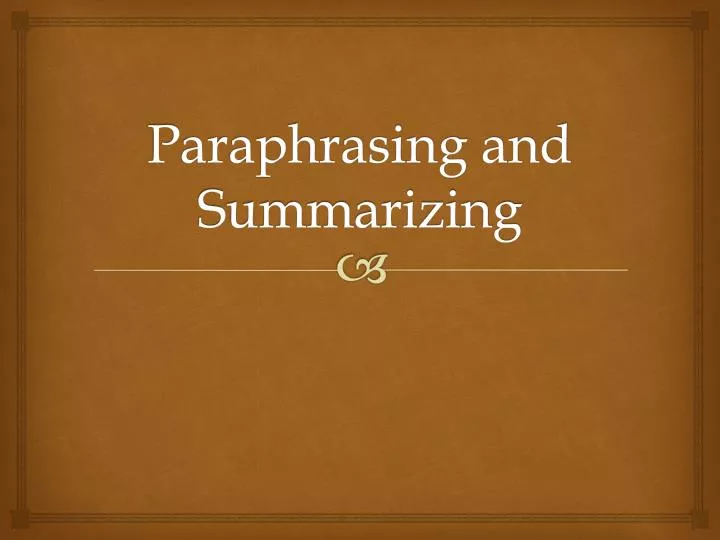

Paraphrasing and Summarizing
Jul 26, 2014
1.27k likes | 3.31k Views
Paraphrasing and Summarizing. What is paraphrasing?. It is one way of incorporating borrowed information or ideas into your research paper. A paraphrase is putting someone else’s thoughts or words into your own words and voice.
Share Presentation
- difficult material
- original text
- great skill
- unique terms

Presentation Transcript
What is paraphrasing? • It is one way of incorporating borrowed information or ideas into your research paper. • A paraphrase is putting someone else’s thoughts or words into your own words and voice. • It is a more detailed than a summary because it focuses not on the main points but more details. • It is a tool for ensuring that you fully understand what the original text said.
What paraphrasing is not! • Paraphrasing is not just inserting a few synonyms for some of the words in a passage. • It is not rearranging the order of the words in a sentence. • It is not taking someone else’s ideas or information, using them and then claiming them to be your own ideas. • Paraphrasing still requires you to cite where you found the idea or information.
How do I paraphrase? • Reread the original passage several times. It is okay to reread because that is a great skill to use when reading difficult material.It, also, gives you the chance to get a good grasp of what information is in the passage. • After you’ve read the passage several times, set it aside and write your own version. Don’t have the passage in front of you, or you will find yourself putting in too many of the same words or just inserting synonyms.
How do I paraphrase? • Write down a word or two to remind you of where you will want to use this information in the paper. If you don’t do this step, then when you start to write the paper, you’ll forget why you found that information so important. • Look at the original passage and make certain your paraphrase accurately captures the important information in a new form. • If you borrowed a few unique terms or phrases from the source, then go ahead and put quotation marks around those words.
How do I paraphrase? • Be sure you record the source (including the page if is a book or a paragraph number if it is a database or website). • Remember even though you are paraphrasing, or using you own words and voice, you still must cite your source. If you don’t cite your source, then you have committed PLAGIARISM!
What is the difference between paraphrasing and summarizing? • Summarizing, like paraphrasing, takes ideas and information and requires you to put information into your own words and voice. • Summarizing is not as detailed as paraphrasing. • It has you put the main points of a passage in your own words. It is a broad overview of the material.
Summaries: Capture an entire article • Paraphrase: Capture a chunk of information (similar to a summary) If you use words that are unique to the author, be sure to use quotation marks around those words. But “” should never be around several sentences. • Direct Quotes: Capture a significant sentence from article.
Direct Quotes and Internal Citations • What do you need: • Parenthesis • Author’s Name (only last) • No author, no problem – Use an abbreviated title • Page # • Quotation marks around direct quotes • THE PERIOD IS AFTER THE CLOSING PARENTHSIS. • EX. • Wordsworth stated that Romantic poetry was marked by a "spontaneous overflow of powerful feelings"(Ralph 263).
Summarizing and Paraphrasing Assignment • 1. Read the article “ The NCAA Weekend’s Biggest Winner” • 2. On a separate sheet of paper, apply what you have learned about DIRECT QUOTES, SUMMARIZING, AND PARAPHRASING. Requirements: • Summarize the entire article • Within your summary, use quotation marks to paraphrase material from article – boxed and labeled • You will also need to find 2 significant sentences that you will use for Direct Quotes with the correct format – highlight sentences Paraphrased material and Direct Quotes must be cited
- More by User
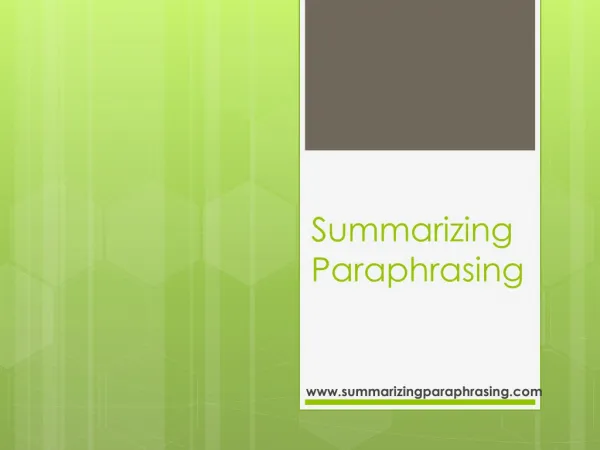
Summarizing Paraphrasing
summarizingparaphrasing.com. If you need to get the best summarizing paraphrasing you should only visit our site summarizingparaphrasing.com And our expert team will help you to achieve all your desires and requirements.
258 views • 9 slides

Paraphrasing, Summarizing and Plagiarizing
Paraphrasing, Summarizing and Plagiarizing. Paraphrasing. What is it? Putting something in your own words can be the shorter, the same length or longer than the original goal is not to shorten the original; goal is to restate it in your own words Do you have to cite a paraphrase?
327 views • 13 slides
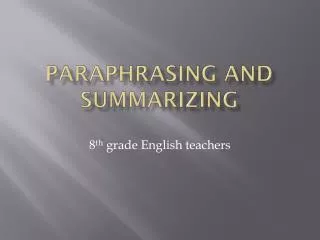
Paraphrasing and Summarizing . 8 th grade English teachers . What does paraphrase mean? . Taking someone else’s information and putting it into your own words and ideas Example: No Fear Shakespeare edition of A Midsummer Night’s Dream A more detailed restatement than a summary
809 views • 17 slides

Quoting, Paraphrasing, and Summarizing
Quoting, Paraphrasing, and Summarizing. Quotations must be identical to the original, using a small segment of the source. They must match the source document word for word and must be attributed to the original author. Quoting.
677 views • 16 slides
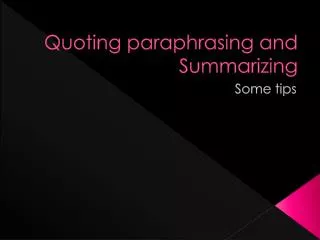
Quoting paraphrasing and Summarizing
Quoting paraphrasing and Summarizing. Some tips. 1.8. Paraphrasing Ex 4. B) It began / started / began in France and Germany but took off / developed / improved / accelerated in the United States .
537 views • 29 slides

Summarizing and Paraphrasing
486 views • 6 slides

Quoting paraphrasing and Summarizing. Some tips. Exercise 1.18 . 5b. After the second world war , the development of ‘ planned obsolescence ’ by the industry encouraged customers to buy new cars more often than they needed to by increasing the frequency of model changes . .
410 views • 26 slides
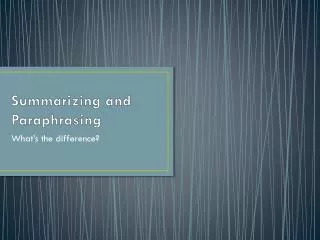
Summarizing and Paraphrasing. What’s the difference?. Summarizing. Summarizing. What Is Summarizing? Summarizing is how we take larger selections of text and reduce them to their bare essentials: the gist, the key ideas, the main points that are worth noting and remembering. .
469 views • 16 slides

Summarizing and Paraphrasing . Summarizing . A summary is always shorter than the original material, and it is mostly on main ideas rather than details. . How to Summarize. Read the material , including the title Begin your summary with main idea . This sentence is your topic sentence.
421 views • 25 slides

Paraphrasing and Summarizing. What is paraphrasing? Quote someone’s idea indirectly Rephrase or rewrite Must not change the meaning Avoid plagiarism. Original passage
369 views • 9 slides


Quoting, paraphrasing, and summarizing
Quoting, paraphrasing, and summarizing. Research and Writing. More reasons to include source material In your own writing . Below are some reasons you might want to incorporate source material into your own writing: Provide support for claims or add credibility to your writing
421 views • 21 slides

Quoting, Paraphrasing, and Summarizing. Supporting Ideas and Requiring Citations. Quotations. Must be identical to the original, using a narrow segment of the source Must match the source document word for word Must be attributed to the original author. Paraphrasing.
363 views • 15 slides

Quoting, paraphrasing, and Summarizing
Quoting, paraphrasing, and Summarizing. Ways to incorporate others’ ideas into your writing. What’s the Difference?. Quotations must be identical to the original , using a narrow segment of the source, and must be attributed to the original author.
292 views • 8 slides
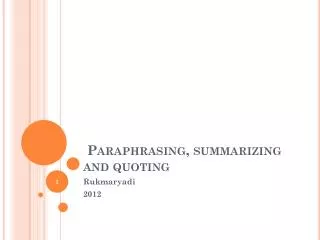
Paraphrasing, summarizing and quoting
Paraphrasing, summarizing and quoting. Rukmaryadi 2012. Paraphrasing “ A paraphrase is a translation, restatement or rewording “. Untuk tidak mencontoh / menciplak hasil tulisan atau perkataan orang lain perlu kita mempelajari bagaimana cara membuat paraphrasing
772 views • 17 slides

Paraphrasing and Summarizing. Accuracy is the key, but must be done in your own words. Paraphrasing. It is a tool used in summarizing, but is not a summary writing itself. It is shorter The aim is to re-present the information and concept in different words
307 views • 10 slides
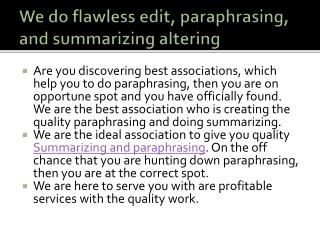
Summarizing and paraphrasing are different, yet similar ways of presenting information, and both of these are extremely important in writing all kinds of documents.
232 views • 9 slides

Summarizing and Paraphrasing. Academic Writing in English. What is the difference between summarizing and paraphrasing ?. Paraphrasing.
389 views • 11 slides

Quoting, Paraphrasing, and Summarizing. Analytical and Rhetorical Writing Matt Barton. Sources and Ethos. Part of the college experience is learning how to discover information on your own.
513 views • 26 slides

Paraphrasing and Summarizing. Prof. Myrna Monllor English 112. Paraphrasing. Stating/Transforming ideas that you have read into your own words Being able to paraphrase demonstrates that you have understood what you have read You should always cite the original source of the information.
413 views • 11 slides

Summarizing/Paraphrasing
Summarizing/Paraphrasing. Summarizing. A summary is a short piece of writing about a longer piece. A summary includes only the most important details or main ideas. How to summarize:. 1. Pick out the main idea.
279 views • 14 slides

Paraphrasing, Summarizing, and Plagiarism
Paraphrasing, Summarizing, and Plagiarism. An Overview. Paraphrasing. What is paraphrasing? A way to incorporate a source’s ideas without directly quoting the source Using your own words to convey another author’s information
1.09k views • 9 slides

Summarizing and Paraphrasing. Academic Writing in English. What is the difference between summarizing and paraphrasing ?. A summary generalizes the original text in your own words, omitting all unnecessary information.
344 views • 19 slides

- My presentations
Auth with social network:
Download presentation
We think you have liked this presentation. If you wish to download it, please recommend it to your friends in any social system. Share buttons are a little bit lower. Thank you!
Presentation is loading. Please wait.
Paraphrasing and Summarizing
Published by Carmel Marsh Modified over 6 years ago
Similar presentations
Presentation on theme: "Paraphrasing and Summarizing"— Presentation transcript:

Greg Bacon, Gabe Peters, and Alex Swanson Period One

Jenny Havens Ozark Christian College Learning Center

PERSUASIVE WRITING How well can you organize and express your ideas in written text to convince the reader of your position?

Steps to Write Summary of Story

Coach Jordan English 2. Analyze the Prompt Break down the prompt…identify the topic or situation, your writing purpose, the product you must create,

Stuff you never knew about Bats

ESSAY WRITING Can be fun.

Writing an “A” Paper.

Revising and Editing Checklist - Review

Alana Jensen Gonzales-Stoller Surveillance ESER Program.

California State Writing Test

Useful tips © Gerlinde Darlington MEd.Mag.phil.. Introduction Main part – consisting of a few paragraphs Conclusion Remember: poorly structured.

Bat The King of the Caves By: KV. Introduction. Bats are mammals It’s scientific name is chiropeta It means wings on their hands They are the only mammals.

What To Think about before Typing Your Research Paper.

Summary Writing-4 th Grade Mr. Picon Room 2. What is a Summary? 1.A summary is a shortened, condensed version. 2.The purpose of a summary is to share.

Summarizing, Paraphrasing, and Synthesizing

How to Write and Revise a Rough Draft Inter American University of PR Bayamón Campus GEEN 2313 Prof. Gladys Cruz.

LITTLE BROWN BATS FLYING NIGHTMARES Power Point by Rafferty.

By: Elena Rodriguez, Mateo Schuab, Kai Unfried and Catalina Segura

Birds vs. Bats Bats are mammals. They have fur or hair. A baby bat is born live. The babies nurse from their mom. Bats have arms, hands and feet. They.
About project
© 2024 SlidePlayer.com Inc. All rights reserved.

COMMENTS
The document discusses paraphrasing, summarizing, and provides examples of each: - Paraphrasing is restating a text in your own words to show you understand the meaning, while summarizing reduces the text and focuses only on the key points and most important ideas.
Grad class paraphrasing, summarizing, and quoting slide share. This document discusses paraphrasing, summarizing, and quoting in research papers. Paraphrasing rewrites text in one's own words while maintaining a similar length, and summarizing also rewrites text but in a more concise way.
Paraphrasing & Summarizing Strategies for Avoiding Plagiarism. HOW TO WRITE A SUMMARY. There are many situations in the workplace, at the university, in your life in which it is necessary to summarise information.
paraphrase & summarize. Paraphrase paraphrase --> express someone else's ideas in your own language A restatement of a text in another form or other words. It is one way of incorporating borrowed information or ideas into your research paper. A paraphrase is putting someone else’s thoughts or words.
A paraphrase must MAKE SENSE. Synonym A synonym is a word that has the same meaning or a very close meaning to the original word. Examples: A synonym for pretty is lovely. A synonym for starving is famished. A synonym for purple is amethyst.
Good readers are active and engaged while reading. Summarizing Is A Powerful Learning Strategy. Summarizing Is Also A Powerful Life Skill. Paraphrasing. Paraphrasing means putting information into your own words. You can paraphrase: DownloadPresentation. identify. identify details.
Summaries: Capture an entire article • Paraphrase: Capture a chunk of information (similar to a summary) If you use words that are unique to the author, be sure to use quotation marks around those words. But “” should never be around several sentences. • Direct Quotes: Capture a significant sentence from article.
Summarizing describes the key points of a larger section or piece of work. The document outlines best practices for paraphrasing like citing sources, using synonyms, altering sentence structure, and breaking information into separate sentences.
Summarizing and Paraphrasing Powerpoint. Learn how to summarize by taking notes and finding main ideas. Learn how to paraphrase by finding key words and rewriting in your own words.
What are you being asked to write about? Read, think about, and understand the text. Review the material to make sure you know it well. Take notes. Write down the main ideas and important details of the article. Write a thesis statement.